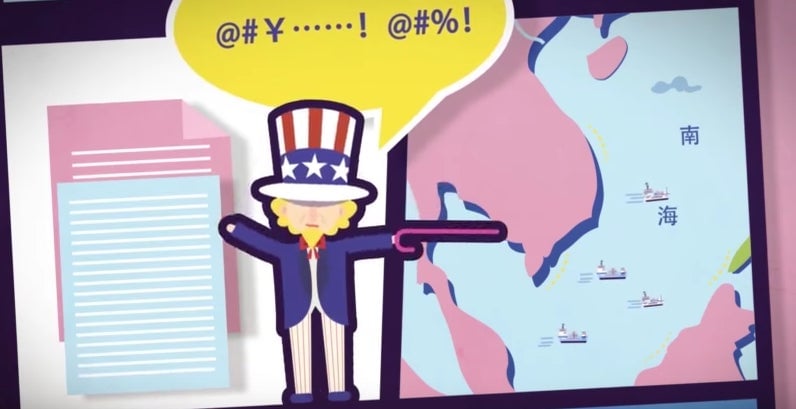An animated video explains why Beijing is right—and the US is wrong—in the South China Sea
Beijing’s claim that most of the South China Sea belongs to China may be questionable, but its public relations campaign has been impressive. The latest trick: an animated video posted to Weibo (link in Chinese) this week by state-run broadcaster CCTV. Weibo is a hugely popular social media platform among China’s youth.


Beijing’s claim that most of the South China Sea belongs to China may be questionable, but its public relations campaign has been impressive. The latest trick: an animated video posted to Weibo (link in Chinese) this week by state-run broadcaster CCTV. Weibo is a hugely popular social media platform among China’s youth.
Full of positive energy, the video begins by appealing to (presumably young) viewers’ love of shopping: “Do you want to buy the most fashionable clothing, or electronic devices with the state-of-the-art technology? You’d better pray for the peace and safety of the ocean.” This is probably an attempt to garner interest among people who would otherwise (and probably still do) find the topic of maritime rights boring.
“Thanks for the editors’ efforts,” one blogger commented under the post. “Only by doing this will our children pay attention.” Another wrote, “It’s our South China Sea—those who stop us from buy buy buy, go die!” So far the video has attracted more than 40,000 reposts, 5,000 comments, and nearly 10,000 likes, 10 times more than other videos produced by the government on the subject.
The animated video is part of a trilogy that explains Beijing’s claim to the South China Sea. The other two videos CCTV posted on Weibo (link in Chinese), which have drawn only hundreds of comments and reposts so far, used historical documents and interviewed senior Chinese fishermen to support the claim.
The animated video explains that China was the first to discover and name the Nansha islands, otherwise known as the Spratly archipelago, where China has in recent years built and militarized artificial islands atop reefs. It states China has exercised jurisdiction over the islands since the Tang Dynasty (which ended over a thousand years ago) and over successive administrations has affirmed sovereignty over the islands with authoritative maps. Beijing has been playing up the importance of historical maps and documents, but when the BBC went searching for a one, it had apparently been thrown away.
The video then mentions the creation of the nine-dashed-line map in the 1940s, which encircled four main island groups in the sea “in order to reiterate and reaffirm China’s sovereignty and related rights in the South China Sea.” The line also encircled nearly the entire sea, overlapping the claims and “related rights” of other nations like Vietnam, Indonesia, and the Philippines, who have maps of their own.
The video next explains that the sea is vital to international trade. This is true—and it’s why much of the world is alarmed at Beijing’s sweeping territorial claims and military buildup in the vital waterway. According to the video, the infrastructure buildup is to “better ensure the safety and freedom of this fishing route.” Others see it as a way for China to better exert its power.
The United States enters the video at around the 2:10 mark as the bad guy, a “powerful nation far away from this region” up to such nefarious activities such as backing the Philippines’ arbitration case in an international tribunal challenging China’s claim, “enhancing patrols near China’s insular features,” and “conducting reconnaissance in waters within China’s jurisdiction.”
The tribunal is the Permanent Court of Arbitration in The Hague. In 2013 the Philippines petitioned it to rule on whether China’s claims are valid under the 1982 United Nations’ Convention on the Law of the Sea, to which all the claimants in the South China Sea signed on. Beijing refuses to acknowledge the tribunal’s authority, but under Article 288(4) of the convention, it’s up to the tribunal to rule where and whether it has jurisdiction.
The “patrols” mentioned are freedom-of-navigation operations conducted by the US Navy on what for decades have been international waters open to all nations—but that China now claims are its territory. With the tribunal likely to rule against most of China’s claims, those patrols will probably grow bolder and include more nations.
China’s propaganda efforts might seem crude, but by and large they work. Just talk to the average Chinese twenty-something about the 1989 pro-democracy protests in Tiananmen Square. Many young Chinese today see Tiananmen, Taiwan, and the South China Sea exactly as Beijing would wish. A video like this, though simple, is capable of shaping opinions.